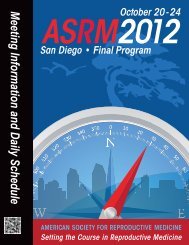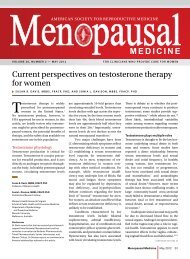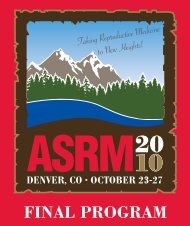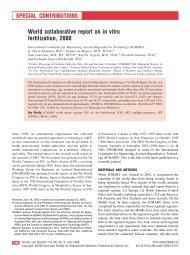scientific program • symposia - American Society for Reproductive ...
scientific program • symposia - American Society for Reproductive ...
scientific program • symposia - American Society for Reproductive ...
You also want an ePaper? Increase the reach of your titles
YUMPU automatically turns print PDFs into web optimized ePapers that Google loves.
POSTHUMOUS REPRODUCTION IN THE MALE AND FEMALE:<br />
LEGAL, ETHICAL AND MEDICAL ISSUES<br />
Presented by the <strong>Society</strong> <strong>for</strong> <strong>Reproductive</strong> Endocrinology Infertility and<br />
the Legal Professional Group<br />
Mark V. Sauer, M.D. (Chair)<br />
Columbia University<br />
Gary S. Nakhuda, M.D.<br />
Columbia University<br />
Judith Daar, J.D.<br />
Whittier Law School<br />
Robert L. Klitzman, M.D.<br />
Columbia University<br />
SCIENTIFIC PROGRAM <strong>•</strong> SYMPOSIA<br />
Monday, October 17, 2011 4:15 pm – 6:15 pm<br />
Symposium<br />
Room 222<br />
Needs Assessment and Description<br />
Refinements in the cryopreservation of reproductive tissues,<br />
gametes and embryos allow <strong>for</strong> children to be conceived<br />
after the death of their genetic parents through the use of<br />
assisted reproduction. Although the techniques are routine,<br />
numerous medico-legal, ethical and psychosocial dilemmas<br />
often arise from these requests, and a multidisciplinary<br />
approach to treatment is required. The increasing demand<br />
<strong>for</strong> these procedures necessitates ASRM members to be<br />
updated on the practice and standard of care related to<br />
posthumous reproduction.<br />
FIBROIDS - NEW INSIGHTS AND EMERGING TREATMENT<br />
OPTIONS<br />
Presented by the Fibroids Special Interest Group<br />
Elizabeth A. Stewart, M.D. (Chair)<br />
Mayo Clinic<br />
Erica E. Marsh, M.D., M.S.C.I.<br />
Feinberg School of Medicine – Northwestern University<br />
Donna Day Baird, Ph.D.<br />
National Institute of Environmental Health Sciences<br />
Needs Assessment and Description<br />
New uterine fibroid research is emerging that highlights the<br />
variability in biologic behavior of this disorder. This variability<br />
has implications <strong>for</strong> clinical care. The goal of this symposium<br />
is to present new in<strong>for</strong>mation on uterine fibroids that directly<br />
impacts clinicians in the field.<br />
69<br />
Learning Objectives<br />
At the conclusion of this session, participants should be able<br />
to:<br />
1. Describe the various techniques used in posthumous<br />
reproduction and recommend a standardized approach<br />
<strong>for</strong> their clinical implementation.<br />
2. Restate the legal and ethical concerns related to<br />
procuring or using reproductive tissues after death.<br />
ACGME COMPETENCY<br />
Medical Knowledge<br />
Patient Care<br />
TEST QUESTION:<br />
After participating in this session, I will do the following in my<br />
practice:<br />
A. Consider gametes, reproductive tissues and embryos<br />
to be the property of the patients and leave the final<br />
disposition of such property up to them or their surviving<br />
spouses.<br />
B. Require all parties to provide an advance written and<br />
witnessed directive prior to the banking of gametes,<br />
reproductive tissues and embryos that includes the<br />
disposition of the material in the event of the patient’s<br />
death.<br />
C. Mandate that all cryopreserved material be destroyed<br />
upon the death of one or both of the parties involved.<br />
D. Not address posthumous reproduction, knowing that the<br />
local judicial system will rule on any request to use<br />
banked tissue, gametes or embryos.<br />
E. Not applicable to my area of practice.<br />
Monday, October 17, 2011 4:15 pm – 6:15 pm<br />
Symposium<br />
Room 224 A/B<br />
Learning Objectives<br />
At the conclusion of this session, participants should be able<br />
to:<br />
1. Summarize new in<strong>for</strong>mation on clinical variability and<br />
racial differences in uterine fibroids.<br />
2. Formulate an individualized approach to treatment of<br />
women with uterine fibroids based on current research.<br />
ACGME COMPETENCY<br />
Medical Knowledge<br />
Patient Care<br />
TEST QUESTION:<br />
After participating in this session, I will do the following in my<br />
practice:<br />
A. Use age but not race in determining treatment options<br />
<strong>for</strong> fibroids.<br />
B. Counsel women that uterine fibroid shrinkage is rare<br />
be<strong>for</strong>e menopause.<br />
C. Recommend surgery to remove all fibroids which more<br />
than double in size in a 6 month period of time.<br />
D. Counsel women that intramural fibroids appear to impair<br />
fertility, but myomectomy does not significantly eliminate<br />
that impairment.<br />
E. Consider symptomatic uterine fibroids a contraindication<br />
<strong>for</strong> a levonorgestrel IUD.<br />
F. Not applicable to my area of practice.








